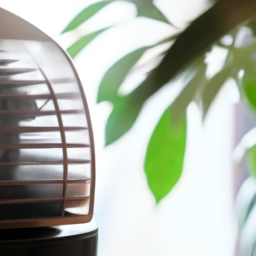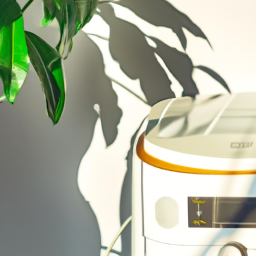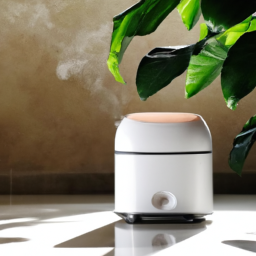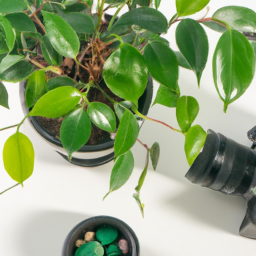
Are you looking to improve the air quality in your home but unsure whether to invest in indoor plants or an air purifier? The debate between Indoor Plants vs Air Purifier has been ongoing, with both options offering unique benefits. In this blog post, we will explore the pros and cons of each to help you make an informed decision on how to create a healthier indoor environment. Whether you have a green thumb or prefer a low-maintenance solution, we’ve got you covered. Let’s dive in and discover which option is best for you and your space.
Benefits of Indoor Plants for Air Quality
Introduction
Indoor plants have been a popular choice for improving air quality in homes and offices for many years. Not only do they add a touch of greenery to indoor spaces, but they also have the ability to filter out harmful toxins and pollutants from the air. In this article, we will explore the benefits of indoor plants for air quality and compare them to air purifiers.
How Indoor Plants Improve Air Quality
Indoor plants are natural air purifiers that can help remove toxins such as formaldehyde, benzene, and trichloroethylene from the air. These toxins are commonly found in indoor environments due to household products, furniture, and building materials. Plants absorb these toxins through their leaves and roots, converting them into nutrients that are used for growth. This process, known as phytoremediation, helps to improve indoor air quality and create a healthier living environment.
In addition to removing toxins from the air, indoor plants also release oxygen during photosynthesis, which can help increase oxygen levels in indoor spaces. This can improve concentration, reduce stress, and boost overall well-being. Plants also release moisture through a process called transpiration, which can help increase humidity levels in dry indoor environments. This is especially beneficial during the winter months when indoor air tends to be drier.
Furthermore, indoor plants can help reduce airborne dust and allergens, making it easier for people with allergies or respiratory conditions to breathe. The presence of plants in indoor spaces has been shown to reduce symptoms such as coughing, wheezing, and congestion. Overall, indoor plants can have a positive impact on both physical and mental health.
Choosing the Right Indoor Plants
When selecting indoor plants for air quality, it is important to choose varieties that are known for their air-purifying properties. Some of the best plants for improving indoor air quality include spider plants, peace lilies, snake plants, and pothos. These plants are easy to care for and can thrive in a variety of indoor environments. It is also important to consider the size of the plant in relation to the space available, as well as the amount of light and water it requires.
In addition to choosing the right plants, proper care and maintenance are essential for maximizing their air-purifying benefits. This includes regular watering, pruning, and cleaning of leaves to remove dust and debris. It is also important to monitor the health of the plants and address any issues such as pests or diseases promptly. By taking good care of indoor plants, you can ensure that they continue to improve air quality in your indoor space.
In conclusion, indoor plants offer a natural and effective way to improve air quality in indoor environments. By choosing the right plants and providing proper care, you can enjoy the many benefits that plants have to offer. Whether you are looking to reduce toxins, increase oxygen levels, or simply add a touch of greenery to your space, indoor plants are a great option for enhancing air quality.

Effectiveness of Air Purifiers in Improving Indoor Air Quality
Introduction
When it comes to improving indoor air quality, many people turn to either indoor plants or air purifiers. Both options have their own set of benefits and drawbacks, but which one is more effective in purifying the air in your home? In this article, we will delve into the effectiveness of air purifiers in improving indoor air quality compared to indoor plants.
Benefits of Air Purifiers
Air purifiers are devices designed to remove contaminants from the air in a room. They work by drawing in air, passing it through filters to remove particles, and then releasing clean air back into the room. One of the biggest benefits of air purifiers is their ability to capture a wide range of pollutants, including dust, pollen, pet dander, and mold spores. This can be especially beneficial for individuals with allergies or respiratory conditions.
Another advantage of air purifiers is their efficiency in removing harmful chemicals and odors from the air. Many air purifiers come equipped with activated carbon filters, which are highly effective at trapping volatile organic compounds (VOCs) and other pollutants that can be harmful to your health. This can help improve the overall air quality in your home and create a healthier living environment for you and your family.
Additionally, air purifiers are easy to use and require minimal maintenance. Most models only require filter replacements every few months, making them a convenient and hassle-free option for improving indoor air quality. With advancements in technology, there are now air purifiers available that are energy-efficient and operate quietly, allowing you to enjoy clean air without any disruptions.
In conclusion, air purifiers offer a range of benefits for improving indoor air quality, including the ability to remove a wide variety of pollutants, chemicals, and odors from the air. They are easy to use, require minimal maintenance, and can create a healthier living environment for you and your family.
Drawbacks of Air Purifiers
While air purifiers have many benefits, there are also some drawbacks to consider. One of the main drawbacks of air purifiers is their cost. High-quality air purifiers can be expensive to purchase upfront, and the cost of replacing filters regularly can add up over time. This may be a deterrent for some people who are on a tight budget and looking for a more affordable option to improve indoor air quality.
Another drawback of air purifiers is their energy consumption. Some models can be energy-intensive, leading to higher electricity bills. It is important to consider the energy efficiency of an air purifier before purchasing one to ensure that it will not significantly increase your energy costs.
Additionally, air purifiers may not be as effective in removing certain pollutants, such as viruses and bacteria, from the air. While some models come equipped with UV-C light technology or HEPA filters that can capture these microorganisms, they may not be 100% effective in eliminating them. This is something to keep in mind if you are looking to specifically target these types of pollutants in your home.
In summary, air purifiers have some drawbacks, including their cost, energy consumption, and limitations in removing certain pollutants from the air. It is important to weigh these drawbacks against the benefits of air purifiers when considering them as a solution for improving indoor air quality.
In conclusion, both indoor plants and air purifiers have their own set of benefits and drawbacks when it comes to improving indoor air quality. It ultimately comes down to personal preference and what works best for your specific needs and living environment. Whether you choose to incorporate indoor plants, air purifiers, or a combination of both, taking steps to improve indoor air quality can have a positive impact on your health and well-being.

Comparing Indoor Plants and Air Purifiers for Improving Indoor Air Quality
Introduction
When it comes to improving indoor air quality, many people turn to indoor plants or air purifiers as solutions. Both options have their own set of benefits and drawbacks, so it’s important to understand the differences between the two before making a decision. In this article, we will compare indoor plants and air purifiers in terms of their effectiveness, cost, maintenance, and overall impact on indoor air quality.
Effectiveness
Indoor plants are known for their ability to naturally filter the air by absorbing toxins and releasing oxygen. Some of the best air-purifying plants include the spider plant, peace lily, and snake plant. These plants can help remove common indoor pollutants such as benzene, formaldehyde, and trichloroethylene. However, it’s important to note that plants can only filter the air in a small area around them, so you would need to have multiple plants placed throughout your home to see significant improvements in air quality.
On the other hand, air purifiers are designed to filter the air continuously, removing a wide range of pollutants including dust, pollen, pet dander, and mold spores. High-quality air purifiers use HEPA filters to capture particles as small as 0.3 microns, making them more effective at improving overall air quality compared to indoor plants. Air purifiers are also more efficient at removing odors and allergens from the air, making them a better option for those with respiratory issues or allergies.
In terms of effectiveness, air purifiers are generally more reliable and consistent at improving indoor air quality compared to indoor plants. While plants can provide some benefits, they may not be as effective at filtering out smaller particles or removing odors from the air.
Cost
When it comes to cost, indoor plants are generally more affordable upfront compared to air purifiers. You can purchase air-purifying plants for as little as a few dollars each, making them a budget-friendly option for improving indoor air quality. However, keep in mind that you may need to purchase multiple plants to see significant improvements in air quality, which can add up over time.
On the other hand, air purifiers can be more expensive upfront, with prices ranging from $100 to $1000 or more depending on the brand and features. In addition to the initial cost, air purifiers also require regular filter replacements, which can add to the overall cost of ownership. However, air purifiers are generally more effective at improving air quality compared to plants, so the higher cost may be worth it for those looking for consistent and reliable results.
In terms of cost, indoor plants are a more budget-friendly option for improving indoor air quality, while air purifiers may require a larger upfront investment but offer more reliable and consistent results in the long run.
In conclusion, both indoor plants and air purifiers have their own set of benefits and drawbacks when it comes to improving indoor air quality. Indoor plants are a natural and budget-friendly option that can help filter the air in a small area, while air purifiers are more effective at removing a wide range of pollutants and providing consistent results. Ultimately, the best choice for you will depend on your specific needs, budget, and preferences. Consider the factors discussed in this article to make an informed decision on whether to choose indoor plants or an air purifier for improving indoor air quality.
Summary Snapshot
Are you looking to improve the air quality in your home but not sure if you should invest in indoor plants or an air purifier? Both options have their own benefits and drawbacks, so let’s break it down. Indoor plants are not only aesthetically pleasing, but they also act as natural air purifiers by absorbing toxins and releasing oxygen. They can help reduce pollutants like formaldehyde and benzene, making your indoor environment healthier and more pleasant to be in. Plus, taking care of plants can be a rewarding hobby that adds a touch of greenery to your living space.
On the other hand, air purifiers are specifically designed to filter out contaminants in the air, such as dust, pollen, pet dander, and mold spores. They are more effective at removing these particles than plants, especially in rooms with poor ventilation or high levels of pollution. Air purifiers are also low-maintenance and can be easily adjusted to target specific allergens or pollutants in your home. However, they can be a bit pricey upfront and require regular filter replacements to maintain optimal performance. Ultimately, the choice between indoor plants and air purifiers depends on your specific needs, budget, and lifestyle. Consider combining both options for maximum air quality benefits in your home.
Your Burning Questions Answered:
Q1. What are the benefits of having indoor plants?
Having indoor plants can improve air quality by reducing carbon dioxide levels and increasing oxygen levels. They can also help reduce stress, boost mood, and add a touch of nature to your indoor space.
Q2. How do air purifiers work?
Air purifiers work by pulling air into the unit and passing it through filters that trap particles like dust, pollen, pet dander, and smoke. The purified air is then released back into the room, creating a cleaner indoor environment.
Q3. Can indoor plants act as air purifiers?
Yes, certain indoor plants have air-purifying properties. Plants like spider plants, peace lilies, and snake plants can help remove toxins from the air and improve air quality in your home.
Q4. Are air purifiers more effective than indoor plants at purifying air?
Air purifiers are designed specifically to purify air and can be more effective at removing airborne particles compared to indoor plants. However, having a combination of both indoor plants and an air purifier can provide optimal air purification benefits.
Q5. Which option is better for improving indoor air quality: indoor plants or air purifiers?
Both indoor plants and air purifiers have their own benefits when it comes to improving indoor air quality. Indoor plants add a natural touch to your space and can help remove toxins, while air purifiers are more effective at removing particles from the air. Consider using a combination of both for the best results in creating a clean and healthy indoor environment.
Dr. Olivia Green is a botanist with over two decades of experience in indoor plant cultivation. She holds a Ph.D. in Plant Biology and has dedicated her career to researching plant behavior in controlled environments. Dr. Green is passionate about helping plant enthusiasts master the art of indoor gardening through her extensive knowledge and practical insights.


